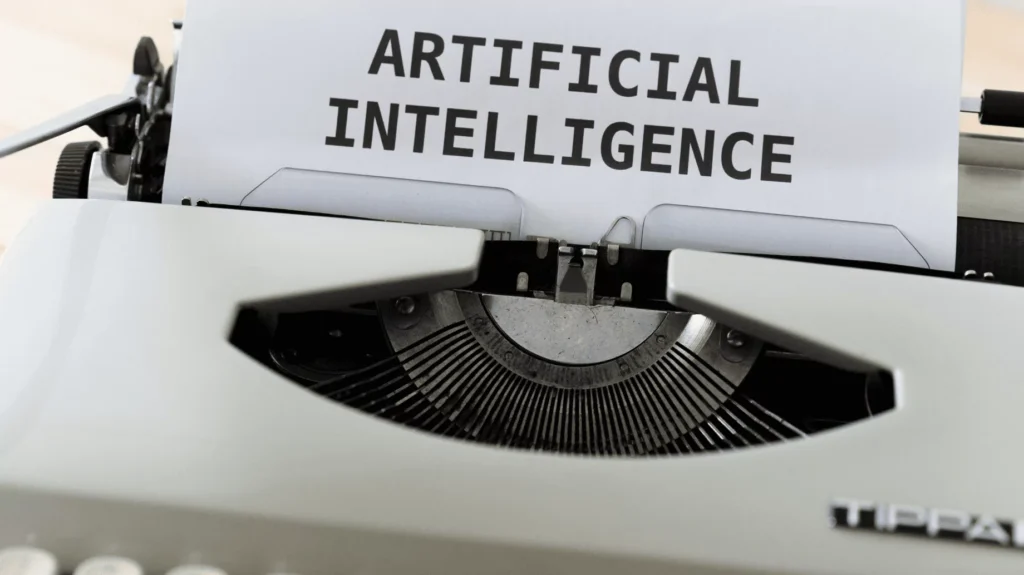AI (artificial intelligence) is changing the landscape of vehicle production, driving, and maintenance, from autonomous vehicles to smart manufacturing processes. This shift is improving safety and efficiency and paving the way for a more connected and automated future in transportation.
AI-powered systems are now integrated into various vehicle design and production aspects, enabling predictive maintenance, optimizing supply chains, and enhancing the overall driving experience.
In this guide, you will discover how artificial intelligence in automotive industry revolutionizes how we move and interact with our surroundings.
Autonomous driving technology
The advent of autonomous driving technology marks a revolutionary shift in the artificial intelligence automotive industry, where vehicles operate with minimal or no human intervention. This technology, powered by sophisticated automotive AI, has the potential to redefine our understanding of mobility, safety, and convenience.
Below are the main benefits of autonomous driving technology.
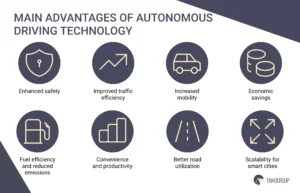
In general, autonomous driving technology fundamentally depends on cutting-edge sensors, sophisticated machine learning models, and real-time data analysis. Vehicles featuring autonomous systems use a variety of sensors, including cameras, radar, LiDAR (Light Detection and Ranging), and ultrasonic sensors.
These devices collectively offer a detailed view of the vehicle’s environment, gathering information about other vehicles, pedestrians, traffic signs, and surrounding conditions. The combination of these sensors allows autonomous vehicles to precisely detect and understand their environment.
Machine learning (ML) is crucial in this process, enabling vehicles to navigate complex driving scenarios effectively. AI algorithms are trained on extensive datasets to recognize patterns and make instant decisions, facilitating effective navigation in various driving scenarios.
To build these models successfully, AI teams often collaborate with top data labeling companies in the USA that provide the annotated datasets necessary for training high-performance automotive systems.
This training involves simulations and real-world testing, where algorithms are exposed to diverse driving conditions and scenarios to enhance their ability to handle various traffic situations. As these models continuously learn from new data, they improve their accuracy and reliability, contributing to autonomous vehicles’ overall safety and efficiency.
Real-time data processing is another crucial component of autonomous driving technology. The vast amount of data sensors collect must be processed instantaneously to make immediate driving decisions. This requires powerful onboard computers capable of handling high-speed computations.
These computers analyze sensor data, predict potential hazards, and execute driving commands such as steering, acceleration, and braking. The speed and accuracy of this data processing are essential for the vehicle’s ability to respond swiftly to dynamic road conditions and unexpected obstacles.
AI in vehicle design and manufacturing
Artificial intelligence is revolutionizing AI car design and manufacturing, infusing these processes with unprecedented efficiency, precision, and innovation. The integration of AI technologies is reshaping the automotive industry, enabling manufacturers to optimize every stage of vehicle development—from initial design concepts to final production.
Enhancing vehicle design with AI
AI in cars has fundamentally transformed vehicle design, introducing new levels of creativity and functionality. Traditionally, vehicle design was a labor-intensive process involving numerous iterations and manual calculations. AI streamlines this process by utilizing advanced algorithms and computational power to rapidly simulate and analyze design options.
A notable application of AI in automotive design is generative design, which utilizes AI algorithms to investigate a wide range of design options within established parameters. Generative design enables engineers to create highly optimized structures and components by evaluating numerous variations and selecting the best-performing designs. This leads to vehicles that are lighter, more efficient, and also feature enhanced durability and innovation.

AI in automotive industry also significantly enhances ergonomics and user experience. By analyzing vast amounts of data from user feedback and driving simulations, AI systems can predict and address design flaws before they manifest in physical prototypes. This predictive ability enables designers to develop interiors that are more comfortable and user-friendly, thereby improving the overall satisfaction of both drivers and passengers.
Optimizing manufacturing processes
In manufacturing, AI enhances efficiency and precision by automating and optimizing various stages of production. The automation systems are engineered to handle intricate tasks like assembly, welding, and painting with exceptional precision and efficiency. Unlike traditional manufacturing methods, AI-driven robots can adapt to different tasks and make real-time adjustments based on data from sensors and cameras.
AI in the automotive industry also plays a significant role in quality control and identifying defects. Advanced computer vision systems, powered by machine learning, can inspect and analyze every component and finished vehicle for defects with precision far exceeding human capabilities. These systems can identify even the tiniest defects, guaranteeing that only vehicles meeting the highest quality standards are provided to customers.
Another critical application of artificial intelligence in car manufacturing is predictive maintenance. AI algorithms assess data from machinery and equipment to forecast possible failures before they happen. This proactive maintenance strategy helps minimize downtime, cut repair expenses, and ensures a more dependable production process. Manufacturers can maintain optimal operational efficiency and avoid costly disruptions by anticipating and addressing issues before they become critical.
Accelerating innovation and sustainability
AI is accelerating innovation in vehicle design and manufacturing by facilitating the development of cutting-edge technologies. For instance, AI is instrumental in advancing electric vehicle (EV) technology, including battery design and energy management systems. By analyzing data on battery performance and environmental conditions, AI in cars helps create more efficient and longer-lasting batteries, contributing to the broader adoption of sustainable transportation solutions.
AI for enhanced vehicle safety
By employing the power of AI in automotive industry, manufacturers are developing advanced systems that not only protect drivers and passengers but also anticipate and mitigate potential hazards on the road.
Intelligent driver assistance systems
Advanced Driver Assistance Systems (ADAS) encompass features such as adaptive cruise control, lane-keeping assist, automatic emergency braking, and collision warning systems.
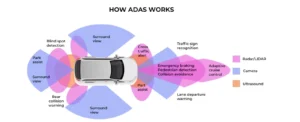
For example, adaptive cruise control uses AI to maintain a safe distance from the vehicle ahead by automatically adjusting the speed based on traffic conditions. This functionality helps prevent rear-end collisions and improves comfort on long drives. Lane-keeping assist uses AI to track lane markings and subtly steer the vehicle to avoid unintended lane changes, tackling a frequent cause of accidents linked to driver distraction or drowsiness.
Automatic emergency braking systems, powered by AI for cars, can detect imminent collisions and apply the brakes autonomously to mitigate the impact or avoid the collision altogether. These systems rely on a combination of sensors and AI-driven algorithms to assess the likelihood of a crash and react faster than a human driver could, potentially saving lives and reducing the severity of accidents.
Advanced collision avoidance technologies
AI is also instrumental in developing advanced collision avoidance technologies that enhance vehicle safety by detecting and responding to potential threats before they escalate. One such technology is the AI-powered object detection system, which utilizes cameras and radar to identify and track objects in the vehicle’s path, such as pedestrians, cyclists, and other vehicles.
By continuously analyzing data from these sensors, AI cars algorithms can predict the movement of detected objects and assess the risk of a collision. This allows the vehicle to take preemptive actions, such as adjusting speed, changing lanes, or even evasive maneuvers if necessary. These systems provide an additional layer of protection by addressing potential hazards that may not be immediately apparent to the driver.
Furthermore, AI-driven driver monitoring systems are designed to ensure that drivers remain attentive and alert while operating their vehicles. These systems employ cameras and biometric sensors to track driver behavior, such as eye movements, facial expressions, and head position. Suppose signs of drowsiness or distraction are detected. In that case, the system can issue warnings or activate corrective measures, such as adjusting the vehicle’s speed or providing alerts to encourage the driver to take a break.
Enhanced vehicle-to-everything (V2X) communication
AI in cars plays a crucial role in enhancing vehicle-to-everything communication, which involves exchanging information between vehicles, infrastructure, and other road users. V2X communication aims to improve safety by enabling vehicles to share real-time data about their location, speed, and direction with traffic management systems.
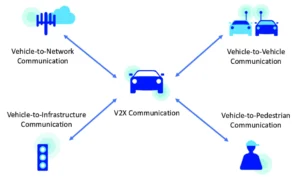
AI algorithms in vehicles process this data to forecast and control traffic flow, alleviate congestion, and improve road safety. For instance, V2X communication can provide warnings about upcoming traffic signal changes, road hazards, or construction zones, allowing drivers to adjust their behavior in advance. This proactive traffic management strategy aids in accident prevention and promotes smoother, safer driving experiences.
Furthermore, AI-powered predictive analytics can uncover patterns and trends in traffic accidents and incidents, offering crucial insights for enhancing road infrastructure and safety protocols. By analyzing historical data and current conditions, automotive AI can recommend changes to traffic management strategies, such as adjusting signal timings or implementing new road safety features.
Personalized user experience of automotive AI
Personalized user experience (UX) offers drivers and passengers a tailored, intuitive, and engaging interaction with their vehicles. Through the integration of artificial intelligence in cars, automotive manufacturers are elevating the driving experience to new levels of convenience, comfort, and personalization.
AI-driven infotainment systems
These systems are designed to provide a customized in-car entertainment and information experience based on individual user preferences. AI cars algorithms analyze user data, such as preferred music genres, favorite radio stations, and frequently visited destinations, to create a personalized entertainment and navigation experience.
For instance, AI-powered voice recognition systems can understand and respond to natural language commands, allowing drivers to control various functions without taking their hands off the wheel. These systems improve accuracy over time by learning from previous interactions, offering increasingly relevant and personalized responses.

Additionally, AI in cars can recommend music playlists, podcasts, or audiobooks based on the driver’s preferences and mood, ensuring a more enjoyable and engaging driving experience.
Adaptive driver profiles
Automotive AI enhances vehicle personalization through adaptive driver profiles, automatically allowing the vehicle to adjust settings based on individual driver preferences. These profiles can include adjustments to seat position, climate control, steering wheel orientation, and mirror settings. By recognizing the driver through biometric data or critical fob recognition, the vehicle can instantly recall and apply these settings, ensuring optimal comfort whenever the driver gets behind the wheel.
Furthermore, adaptive driver profiles extend to driving behavior and performance preferences. AI cars systems can analyze driving patterns and adjust vehicle dynamics to match the driver’s style, whether they prefer a sportier or more relaxed driving experience. This customization enhances driving comfort and contributes to a more enjoyable and personalized journey.
Intelligent navigation and route planning
AI in the automotive industry also plays a crucial role in enhancing navigation and route planning by providing personalized recommendations based on real-time data and user preferences. AI-powered navigation systems evaluate traffic conditions, road closures, and historical data to recommend the most efficient routes. They can also offer personalized route recommendations based on drivers’ habits, such as avoiding routes with frequent congestion or highlighting scenic drives.
Moreover, automotive AI can integrate with other user data, such as calendar appointments or location-based preferences, to provide contextually relevant route suggestions. For example, if a driver has a meeting scheduled, the system can recommend the optimal departure time and route to ensure timely arrival. By leveraging AI, navigation systems can offer a more intuitive and customized experience that aligns with the driver’s needs and preferences.
Improved in-car connectivity
The rise of AI in automotive industry has also advanced in-car connectivity, allowing vehicles to seamlessly integrate with smartphones, smart home systems, and other digital ecosystems. AI-driven connectivity features enable drivers to control various aspects of their smart home, such as adjusting thermostat settings or checking security cameras directly from the vehicle’s infotainment system. This integration creates a cohesive and personalized experience, enhancing convenience and connectivity for users.
Moreover, AI-powered applications can sync with social media platforms, messaging apps, and other digital services to provide personalized notifications and updates. For example, artificial intelligence in cars can alert drivers to essential messages or social media updates while ensuring that these notifications are delivered in a non-distracting manner. This seamless integration enhances the driving experience by keeping drivers informed and connected while maintaining safety.

Reliable Data Services Delivered By Experts
We help you scale faster by doing the data work right - the first time

AI in supply chain and logistics
By using automotive AI technologies, manufacturers achieve remarkable efficiency, accuracy, and agility in managing their supply chains. This transformation optimizes operational processes, drives significant cost savings, and enhances overall performance.
Optimizing inventory management
Traditional inventory management methods often involve complex forecasting models and manual adjustments, which can be prone to inaccuracies and inefficiencies. AI in vehicles leverages sophisticated algorithms to assess historical data, market trends, and real-time information, allowing for precise demand predictions.
Utilizing machine learning techniques, AI cars systems can uncover patterns and trends that may not be visible with conventional methods. This capability enables more accurate inventory forecasting, reducing the likelihood of stockouts and excess inventory. AI-driven inventory management helps automotive manufacturers maintain optimal stock levels, lowering surplus inventory costs and enhancing cash flow.
Enhancing demand forecasting
AI’s potential extends to demand forecasting, an essential element of supply chain management. With predictive analytics, automotive AI can examine extensive data sources such as market trends, consumer behavior, and economic indicators to produce precise demand forecasts. This allows manufacturers to synchronize their production schedules and supply chain operations with expected demand.
For instance, AI in cars can analyze social media trends, customer reviews, and sales data to predict changes in consumer preferences and adjust inventory levels accordingly. By providing more accurate demand forecasts, AI helps manufacturers avoid production delays, optimize resource allocation, and better meet customer expectations.
Streamlining logistics and transportation
AI in cars revolutionizes logistics and transportation by improving route optimization, load planning, and real-time tracking. Traditional logistics management often involves manual planning and coordination, which can lead to inefficiencies and delays. AI-powered systems automate logistics processes, leading to more efficient and cost-effective operations.
AI-based route optimization algorithms assess factors like traffic, weather, and road closures to identify the most efficient transportation routes. This helps decrease delivery times and cut fuel consumption and related expenses. AI can also optimize load planning by analyzing cargo characteristics and vehicle capacities to ensure maximum utilization of transport resources.
Real-time tracking systems equipped with AI provide visibility into the status and location of shipments throughout the supply chain. This allows manufacturers to track delivery progress, detect possible delays, and make proactive adjustments to guarantee timely arrivals. AI-driven tracking systems improve transparency and facilitate better coordination among suppliers, manufacturers, and logistics providers.
Enhancing supplier relationship management
Effective management of supplier relationships is vital for a successful automotive supply chain. AI improves this area by offering insights into supplier performance, risk evaluation, and contract management. AI algorithms analyze data from various sources to assess supplier reliability, quality, and delivery performance.
For example, automotive AI can assess historical performance data to identify patterns of delays or quality issues with specific suppliers. This enables manufacturers to take corrective actions, such as seeking alternative suppliers or negotiating better terms. AI-driven risk assessment tools can also analyze geopolitical risks, financial stability, and supply chain disruptions to mitigate potential risks and ensure a resilient supply chain.
Environmental impact and sustainability
As the world faces increasing environmental challenges, integrating AI vehicles technologies is helping automotive manufacturers reduce their ecological footprint, optimize resource use, and develop more sustainable practices.
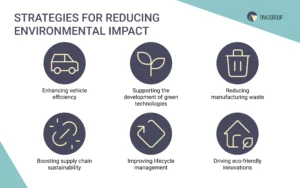
Enhancing vehicle efficiency
AI cars technologies are instrumental in optimizing various aspects of vehicle performance, including fuel consumption, energy management, and emissions control. Sophisticated AI algorithms in vehicles process real-time data from sensors and onboard systems to enhance engine performance, modify driving dynamics, and boost fuel efficiency.
In electric vehicles (EVs), AI is essential for managing battery performance and optimizing energy use. AI-driven systems monitor battery health, predict charging needs, and optimize energy usage to extend battery life and range. By improving the efficiency of energy storage and consumption, AI in cars helps reduce the overall environmental impact of EVs and supports the transition to cleaner transportation.
Supporting the development of green technologies
AI in the automotive industry also facilitates the development of green technologies that contribute to a more sustainable automotive industry. AI is significantly influencing the development of alternative powertrains and renewable energy sources. For instance, AI algorithms are employed to design and enhance hydrogen fuel cell systems, which present a viable alternative to conventional internal combustion engines.
AI-driven research and development are accelerating the creation of advanced materials and technologies that reduce the environmental impact of vehicle production. This includes developing lightweight materials that improve fuel efficiency and using sustainable manufacturing processes that minimize waste and energy consumption. By supporting the development of these green technologies, automotive AI is helping the automotive industry transition to more sustainable and eco-friendly solutions.
Reducing manufacturing waste
AI is revolutionizing manufacturing processes in the automotive industry by minimizing waste and enhancing resource efficiency. In automotive production, AI systems are employed to oversee and regulate production processes, ensuring optimal material use and minimal waste. Machine learning algorithms analyze data from production lines to pinpoint inefficiencies, improve material utilization, and lower scrap rates.
For example, automotive AI can analyze production patterns and detect anomalies that may lead to excess material usage or defects. By addressing these issues in real time, manufacturers can reduce waste and improve the overall sustainability of their production processes. AI also supports implementing circular economy principles by optimizing the recycling and reuse of automotive components and materials.
Boosting supply chain sustainability
AI in automotive industry is key in enhancing sustainability throughout the automotive supply chain. AI-powered analytics offer crucial insights into supply chain operations, aiding manufacturers in finding ways to lower their environmental footprint. For instance, AI can optimize logistics and transportation routes to minimize fuel consumption and emissions, leading to more sustainable supply chain practices.
Automotive AI also supports evaluating supplier sustainability practices by analyzing data related to environmental performance, resource usage, and compliance with regulatory standards. This enables manufacturers to make informed decisions about their supply chain partners and promote sustainable practices throughout the supply chain.
Improving lifecycle management
Artificial intelligence in cars contributes to environmental sustainability by improving vehicle lifecycle management. AI-driven systems analyze data on vehicle performance, maintenance needs, and usage patterns to optimize the lifecycle of automotive components. AI-driven predictive maintenance extends the life of components and decreases the necessity for early replacements, thus reducing waste and conserving resources.
Additionally, AI in cars supports the development of vehicle end-of-life (EOL) strategies by analyzing data on vehicle disassembly and recycling processes. This enables manufacturers to design vehicles with end-of-life considerations in mind, facilitating the recycling and repurposing of materials and reducing the environmental impact of vehicle disposal.
Driving eco-friendly innovations
AI in cars drives innovation in eco-friendly automotive technologies, such as autonomous driving and intelligent infrastructure. Autonomous vehicles equipped with AI can optimize driving patterns to reduce fuel consumption and emissions, contributing to overall environmental sustainability. AI also supports the development of innovative infrastructure solutions, such as intelligent traffic management systems that reduce congestion and optimize traffic flow, leading to lower emissions and improved air quality.
Challenges and ethical considerations of AI
While AI cars technologies promise significant advancements in vehicle safety, efficiency, and user experience, they also introduce complexities related to data privacy, algorithmic bias, and societal impact.
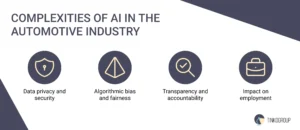
Data privacy and security
Modern vehicles are equipped with sensors, cameras, and connectivity features that collect vast data about vehicle performance, driver behavior, and environmental conditions. This data is essential for powering AI-driven features such as predictive maintenance, driver assistance systems, and personalized experiences. Nonetheless, this also brings up substantial privacy concerns.
It is crucial to ensure the secure management and protection of this data. Automotive manufacturers need to adopt strong data protection strategies to prevent unauthorized access, breaches, and misuse. This includes encrypting data, implementing stringent access controls, and adhering to data protection regulations such as Europe’s General Data Protection Regulation (GDPR). Transparency in collecting, using, and sharing data with third parties is also crucial for maintaining user trust and complying with legal requirements.
Algorithmic bias and fairness
AI vehicles algorithms are designed to make decisions based on data, but they can still be affected by biases present in their training data. Such algorithmic bias can lead to unfair or discriminatory outcomes, especially in systems related to safety and driver assistance. For instance, if a driver assistance system is trained on data that does not fully capture a range of driving conditions or demographic diversity, it might perform inadequately for certain user groups or in specific situations.
To solve these issues, it is crucial to carefully consider and address algorithmic bias during the development and training of AI systems. Automotive manufacturers need to ensure their datasets are diverse and reflective of different driving scenarios and user demographics. Regular audits and tests of AI systems are necessary to maintain fairness and accuracy and to correct any identified biases. Additionally, incorporating input from diverse teams and stakeholders can help develop more equitable and inclusive AI solutions.
Transparency and accountability
The intricate nature of AI cars systems in vehicles can make it difficult to grasp how decisions are made, leading to concerns about transparency and accountability. For example, if an AI-powered vehicle decides that results in an accident, determining the cause and assigning responsibility can be difficult. This opacity can erode user trust and present both legal and ethical challenges.
To resolve these concerns, automotive manufacturers should strive for transparency in AI vehicles systems by providing clear explanations of how decisions are made and ensuring that users understand the capabilities and limitations of AI features. Creating explainable AI models that offer clarity on the rationale behind decisions can improve accountability and build trust. Additionally, establishing clear protocols for addressing and investigating incidents involving AI systems is crucial for maintaining accountability.
Impact on employment
Adopting AI in the automotive industry also raises concerns about its impact on employment. AI-driven automation in manufacturing, logistics, and other areas can lead to job displacement and changes in workforce dynamics. Although automotive AI can generate new job opportunities in technology and data analysis, it might also lead to a decrease in traditional roles.
To address the potential negative effects on employment, it is crucial to invest in workforce development and retraining initiatives. Automotive manufacturers and industry stakeholders should collaborate with educational institutions and training organizations to prepare workers for new roles and skill sets required in an AI-driven industry. Promoting a continuous learning and adaptation culture can help workers transition to new opportunities and ensure a smooth shift in employment dynamics.
Ethical considerations in autonomous vehicles
The development of autonomous vehicles presents unique ethical considerations, particularly in scenarios where AI cars systems must make decisions that involve trade-offs between safety and other factors. For example, in emergencies, a vehicle may need to make decisions about minimizing harm, which raises ethical questions about prioritizing safety and the well-being of different individuals.
Ethical frameworks and guidelines need to be established to steer the decision-making processes of autonomous systems. Engaging with ethicists, policymakers, and the public to establish clear ethical standards and guidelines is crucial for addressing these challenges. Ensuring autonomous vehicles operate within ethical principles can help balance safety, fairness, and societal values.
Conclusion
AI is undeniably shaping the future of the artificial intelligence automotive industry, driving innovations that make vehicles safer, smarter, and more efficient. With the continued advancement of AI technology, even greater enhancements in vehicle design, production, and operation are on the horizon. The integration of AI in cars is a transformative force that will continue to redefine mobility and set new standards in transportation for years to come.
Are you looking to elevate your AI projects with precise data labeling and annotation? Our expert team specializes in high-quality data processing to power AI advancements in automotive technology. Contact us to see how we can improve your AI projects!
How is AI changing the automobile industry?
AI is reshaping the automobile industry by powering autonomous vehicles, improving safety systems, and streamlining manufacturing operations. AI helps vehicles learn from data, improving decision-making and providing smarter, more personalized driving experiences.
Why is AI good in cars?
AI improves driving safety, navigation, and overall convenience. It powers advanced Driver-Assistance Systems (ADAS), automates tasks like parking, and provides real-time insights, making driving more efficient and stress-free.
How does AI work in cars?
AI in cars processes data from sensors, cameras, and radars to make real-time decisions. It identifies objects, predicts movements, and helps the car react safely, supporting features like lane-keeping, collision avoidance, and adaptive cruise control.
What are the disadvantages of AI in cars?
AI in cars can be expensive and may still struggle with complex or unpredictable situations. Excessive dependence on AI may lead to decreased driver involvement, along with worries about data security and the risk of technical errors.





